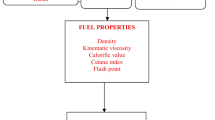Until quite recently, Arctic diesel fuel was produced in accordance with GOST R 55475 with a cold filter plugging point down to –52°C using a depressant-dispersing additive. However, in the Arctic, the temperature drops to –60°C and below, and the use of depressant-dispersing additives provokes product stratification with a sharp deterioration in the properties of the lower layer. This limited the application of Arctic diesel fuel in the Arctic. For such conditions, the Ministry of Defense of the Russian Federation developed its own standards for Arctic diesel fuel without the use of depressant-dispersing additives, and suggesting values not higher than –65°C for the cloud point, pour point and cold filter plugging point. An obstacle for obtaining a product with such properties is the difficulty of simultaneously providing the required cetane number and the low temperature properties. This paper presents a method for obtaining Arctic diesel fuel with the desired properties based on deeply isomerized diesel fractions. To implement the project, the existing units at Slavneft-YANOS PJSC were analyzed, and a chain of units was assembled for primary oil refining, hydrotreating 80 atm and isodewaxing. In the course of a number of experiments new causes of the onset of cold filter plugging point were discovered, which were explained by an increase in the diesel fuel viscosity at extremely low temperatures. To reduce the viscosity of the product, hydrocracked kerosene was added to the formula. In May 2020, permits were received from the Ministry of Defense of the Russian Federation, and in October 2021, for the first time in the Russian Federation and in the world, the first industrial batch of 3,000 tons was successfully produced.




Similar content being viewed by others
References
N. P. Laverov, A. N. Dmitrievsky, and V. I. Bogoyavlensky, Ekologiya i Ekonomika, No 1, 26-37 (2011).
Decree of the President of the Russian Federation of October 26, 2020 No. 645 “On the Strategy for the Development of the Arctic Zone of the Russian Federation and Ensuring National Security for the Period up to 2035” [in Russian].
N. V. Karpov, N. N. Vakhromov, E. V. Dutlov, et al., Khim. Tekhnol. Topliv Masel, No. 4, 57 (2021).
Author information
Authors and Affiliations
Corresponding author
Additional information
Translated from Khimiya i Tekhnologiya Topliv i Masel, No. 1, pp. 11–15 January – February, 2022.
Rights and permissions
About this article
Cite this article
Karpov, N.V., Vakhromov, N.N., Dutlov, E.V. et al. The World’s First Industrial Batch of Arctic Diesel Fuel with Application Temperatures Down to –65°С. Chem Technol Fuels Oils 58, 257–262 (2022). https://doi.org/10.1007/s10553-022-01376-6
Published:
Issue Date:
DOI: https://doi.org/10.1007/s10553-022-01376-6




